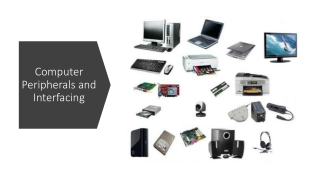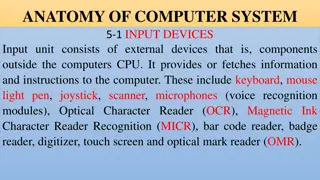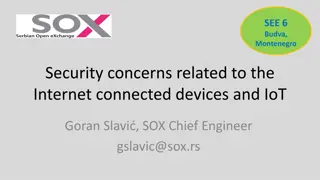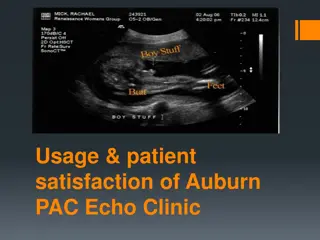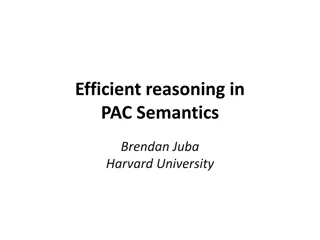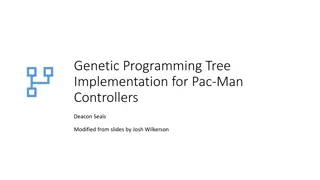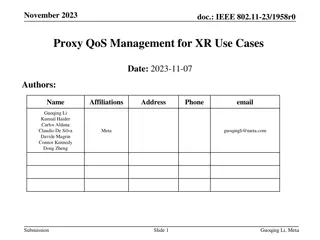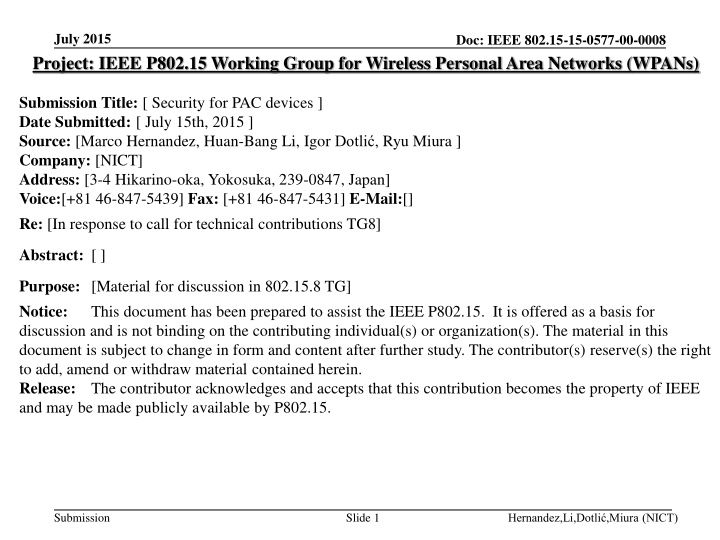
IEEE 802.15-15-0577-00-0008 Security Protocol Overview
Explore the security aspects of PAC devices as discussed in the IEEE 802.15-15-0577-00-0008 document submitted by Marco Hernandez, Huan-Bang Li, Igor Dotli, and Ryu Miura from NICT. Delve into key elements like key establishment, authentication, encryption, integrity, and the choice between block ciphers like AES and stream ciphers like Cha-cha20 for enhanced security in wireless personal area networks (WPANs).
Download Presentation

Please find below an Image/Link to download the presentation.
The content on the website is provided AS IS for your information and personal use only. It may not be sold, licensed, or shared on other websites without obtaining consent from the author. If you encounter any issues during the download, it is possible that the publisher has removed the file from their server.
You are allowed to download the files provided on this website for personal or commercial use, subject to the condition that they are used lawfully. All files are the property of their respective owners.
The content on the website is provided AS IS for your information and personal use only. It may not be sold, licensed, or shared on other websites without obtaining consent from the author.
E N D
Presentation Transcript
July 2015 Project: IEEE P802.15 Working Group for Wireless Personal Area Networks (WPANs) Doc: IEEE 802.15-15-0577-00-0008 Submission Title: [ Security for PAC devices ] Date Submitted: [ July 15th, 2015 ] Source: [Marco Hernandez, Huan-Bang Li, Igor Dotli , Ryu Miura ] Company: [NICT] Address: [3-4 Hikarino-oka, Yokosuka, 239-0847, Japan] Voice:[+81 46-847-5439] Fax: [+81 46-847-5431] E-Mail:[] Re: [In response to call for technical contributions TG8] Abstract: [ ] Purpose: [Material for discussion in 802.15.8 TG] Notice: This document has been prepared to assist the IEEE P802.15. It is offered as a basis for discussion and is not binding on the contributing individual(s) or organization(s). The material in this document is subject to change in form and content after further study. The contributor(s) reserve(s) the right to add, amend or withdraw material contained herein. Release: The contributor acknowledges and accepts that this contribution becomes the property of IEEE and may be made publicly available by P802.15. Submission Slide 1 Hernandez,Li,Dotli ,Miura (NICT)
July 2015 Doc: IEEE 802.15-15-0577-00-0008 Security protocol Also known as cipher suite consists of: Key establishment (typically a Diffie-Hellman variant or RSA) Authentication (by certificate) Confidentiality/encryption (by a symmetric cipher) Integrity (by a hash function) There are two types of ciphers typically used: block ciphers and stream ciphers. In a block cipher, the data is broken up into blocks (fixed size) and each block is encrypted. In a stream cipher, the data is encrypted one byte at a time. Submission Slide 2 Hernandez,Li,Dotli ,Miura (NICT)
July 2015 Doc: IEEE 802.15-15-0577-00-0008 Ciphers Both types of ciphers have pros and cons: block ciphers are generally fast in hardware, while stream ciphers are often fast in software. A popular block cipher is AES. Already implemented in hardware (Intel s Westmare). The 256 bits key version is very fast and very secure. AES is used in most modern computers: servers, desktops, laptops. But AES is not ideal in old computers and mobile devices. No hardware support. Cipher suits are implemented in software. AES is costly in battery life. A low cost stream cipher would be ideal. Submission Slide 3 Hernandez,Li,Dotli ,Miura (NICT)
July 2015 Doc: IEEE 802.15-15-0577-00-0008 Ciphers The standardized stream cipher RC4 is not considered secure anymore. A recent popular security suite choice for low power consumption, as alternative to AES for mobile devices is: Cha-cha20 (stream cipher) with Poly1305 (code authenticator). These have been tested and proven to be fast and secure (no known attack), especially for mobile devices by the academy and industry. The ChaCha20 cipher is designed to provide 256-bit security. The Poly1305 authenticator is designed to ensure that forged messages are rejected. Submission Slide 4 Hernandez,Li,Dotli ,Miura (NICT)
July 2015 Doc: IEEE 802.15-15-0577-00-0008 Ciphers ChaCha20-Poly1305 combines encryption and authentication together. Encrypt-then-authenticate or authenticate-then-encrypt is phased out. Performance: ChaCha20-Poly1305 is three times faster than AES-GCM (128 bits). Submission Slide 5 Hernandez,Li,Dotli ,Miura (NICT)
July 2015 Doc: IEEE 802.15-15-0577-00-0008 Cryptographic Keys Regardless of symmetric, asymmetric or combination of both, encryption, the employed key(s) must be prevented from being guessed. That is, such keys need to be generated truly randomly and contain sufficient entropy. Easier said than done. The problem of how to securely generate truly random keys is difficult. There is a bunch of work in the literature, but out of scope here. What is used in modern computers is cryptographically secure pseudo-random number generators (CSPRG). Submission Slide 6 Hernandez,Li,Dotli ,Miura (NICT)
July 2015 Doc: IEEE 802.15-15-0577-00-0008 Cryptographic Keys Example of a CSPRG (Fortuna) for cryptographic keys generation: enough randomness and entropy Key 256 bits Monotonic counter 128 bits Initialization 128 bits AES block cipher 128 bits XOR Other CSPRGs have been standardized. Submission Slide 7 Hernandez,Li,Dotli ,Miura (NICT)
July 2015 Doc: IEEE 802.15-15-0577-00-0008 PHY key generation Already presented by BJ. We present passive attacks. Challenges and open issues in practice. Submission Slide 8 Hernandez,Li,Dotli ,Miura (NICT)
July 2015 Doc: IEEE 802.15-15-0577-00-0008 PHY key generation Channel probing (pilots and channel estimates) Only possible in TDD. Two devices must have a communication link for channel estimates. Randomness extraction (extract fast fading only) Subtract slow fading (path-loss). The need for devices to move around is self-explanatory: the fast fading must generate enough randomness and entropy for the keys to be secure. Extracting secure keys from quasi-stationary channels is an open problem. Quantization Submission Slide 9 Hernandez,Li,Dotli ,Miura (NICT)
July 2015 Doc: IEEE 802.15-15-0577-00-0008 PHY key generation Information reconciliation Due to imperfect channel reciprocity, bit errors are corrected by FEC. This can generate overhead and ease for an attacker to jam it. Submission Slide 10 Hernandez,Li,Dotli ,Miura (NICT)
July 2015 Doc: IEEE 802.15-15-0577-00-0008 PHY key generation Privacy amplification How to eliminate partial information (correlated bits) by a passive attacker eavesdropping during probing and reconciliation. In practice, it is very hard to estimate how much information is leaked to a eavesdropper. Consequently, privacy amplification becomes nontrivial, hard to decide, and unclear if it is effective. Submission Slide 11 Hernandez,Li,Dotli ,Miura (NICT)
July 2015 Doc: IEEE 802.15-15-0577-00-0008 PHY key generation This uncertainty on leaked information is a bigger problem: Experimental work has shown strong correlation in measurements by eavesdroppers located [significantly] greater than /2 from legitimate devices. Poor multipath scattering, interference scenario are unpredictable. There is no clear safeguard distance to ensure secure key generation. Secure key generation by PHY is still an open issue. Group key generation is an open problem too. Submission Slide 12 Hernandez,Li,Dotli ,Miura (NICT)
July 2015 Doc: IEEE 802.15-15-0577-00-0008 Active attacks The current work on PHY key generation focuses on security analysis under passive attacks. Research on PHY key generation/protocol under active attacks is largely open. For instance: Disruptive jamming: it aims to disrupt the key generation rate by injecting jamming signals during probing. Manipulative jamming: Controlling the channel measurements at legitimate users, compromising the generated keys. Channel manipulation: Controlling the channel between users, and so the generated keys. Details of the attacks can be found in the literature. Submission Slide 13 Hernandez,Li,Dotli ,Miura (NICT)
July 2015 Doc: IEEE 802.15-15-0577-00-0008 Conclusion As an alternative to CSPRG for key generation, this PHY proposal seems to be in the realm of academic research and currently it does not seem ready for a practical and secure implementation for PAC or anything else. Submission Slide 14 Hernandez,Li,Dotli ,Miura (NICT)
July 2015 Doc: IEEE 802.15-15-0577-00-0008 Conclusion II Even assuming securekeys generation, the keys management protocol is the real problem to solve for PAC. The key management protocol is responsible for the creation, revocation and secure distribution of keys (from higher layers). Currently, the weakest point for encryption is the asymmetric handshake that begins the session. If the key for the symmetric encryption is lost/compromised when it is handed off, the rest of the session is insecure, regardless of the method of encryption. In TG9, keys generation is out of the scope of the recommendation as well as encryption algorithms. Maybe we can adopt TG9 specification as the key management protocol. Submission Slide 15 Hernandez,Li,Dotli ,Miura (NICT)


